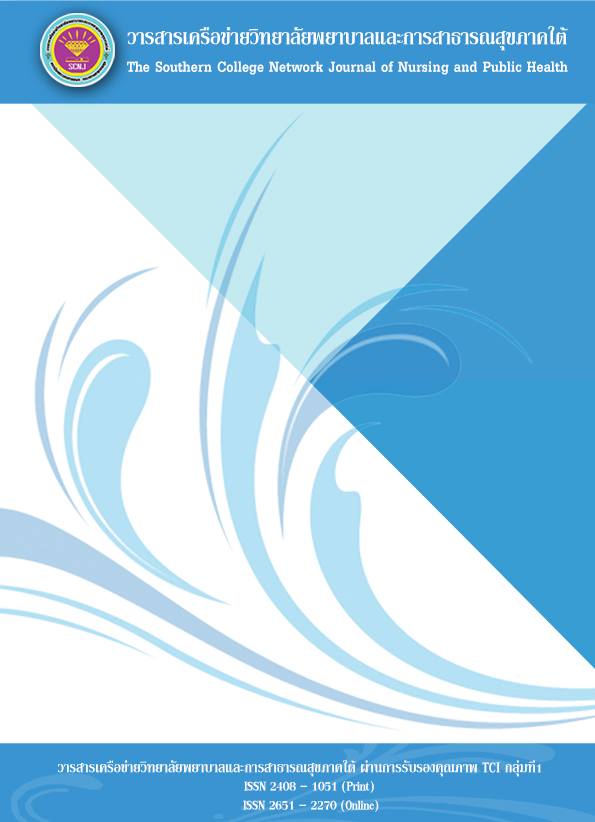ผลของโปรแกรมการให้ความรู้ต่อการพัฒนาทักษะภาษาอังกฤษด้านการฟัง การอ่าน และไวยากรณ์ ของนักศึกษาวิทยาลัยการสาธารณสุขสิรินธร จังหวัดตรัง
คำสำคัญ:
Education Program, English Skills, Listening, Reading and Grammarบทคัดย่อ
This quasi-experimental research with one-group pretest-posttest design aimed to determine the effects of an education program on improving English skills of listening, reading and grammar among students in Sirindhorn College of Public Health, Trang (SCPH Trang). Participants were 295 students in their first, second, and third year at the College, studying either in the Community Public Health and Dental Public Health Curriculums, or Pharmacy Technique and Emergency Medical Operation Curriculums in academic year 2017. Data were collected for five weeks. There were 3 research instruments: 1) an education program of English skills for listening, reading and grammar, 2) a knowledge test, and 3) an attitude and behavior questionnaire for listening, reading and grammar. Reliability of the questionnaire was tested using Cronbach's alpha coefficient, yielding values of 0.86 and 0.94, respectively. Percentage, mean, standard deviation, and paired sample t-test were used for data analysis.
The results showed that the overall attitude and behavior were at a good and high level (M=3.67, SD=0.35, 96.5%, and M=3.05, SD=0.73, 49.6%, respectively). Students who participated in the program of English skills for listening, reading and grammar (M=28.53, SD=6.06) had a statistically higher knowledge after than before the educating the program (M=14.84, SD=3.76) at 0.05 (p < 0.01).
That education program on English skills for listening, reading and grammar, increased the students’cognition and experiences. It could be a guideline to improve students’ English skills. They would not only be ready and confident for yearly English examination, but also pass the requirement.
เอกสารอ้างอิง
Best, J. W. (1977). Research in Education. 3rd ed. New Jersey: Prentice hall Inc.
Bloom, B. S. (1968). Learning for Mastery. UCLA Evaluation Comment, 1(2), 1–8.
Bloom, B. S. (1976). Human Characteristics and School Learning. New York: McGraw-Hill.
Chanrit, S., Sukasem, P., & Reaunnakarn, P. (2010). A Comparison of Listening and Speaking Skills and the Satisfaction in Learning English of Matayomsuksa 1 Students Taught with STAD Cooperative Learning Activities and Learning Activities from the Teacher’s Handbook. Lopburi: Thepsatri Rajabhat University. (in Thai)
Dechawongse, S., & Gomaratut, S. (2016). Learning Styles in Foreign Language of Under-Graduate Students in Thailand. Journal of Educational Review Faculty of Education, 4(3), 49-62. (in Thai)
Hafiz, F. M., & Tudor, I. (1990). Graded Readers as an Input Medium in L2 Learning. System, 18(1), 31-42.
Ministry of Education. (2008). Research and Development of Learning Quality. Journal of Educational Measurement, 27(81), 1-11. (in Thai)
Praboromarajchanok Institute for Health Workforce Development. (2017). English Proficiency Test of Students. Nonthaburi: Praboromarajchanok Institute, Office of the Permanent Secretary Ministry of Public Health. (in Thai)
Sa-Ngiamwibool, A. (2005). Developing Grammar-in-Context Model for EFL Adult Learners. Retrieved on May 25, 2018 from https://sutir.sut.ac.th:8080/sutir/bitstream/123456789/1702/2/amporn_fulltext.pdf.
Shanahan, T. (2013). Grammar and Comprehension: Scaffolding Student Interpretation of Complex Sentences. Retrieved May 25, 2018 from https://www.shanahanonliteracy.com /2013/12/grammar-and-comprehensionscaffolding.html.
Sittichai, R., & Tudkuea, T. (2017). An Investigation of English Learning and Teaching Behavior of Schools Under Christian Foundation in Three Southern Border Provinces. Princess of Naradhiwas University Journal of Humanities and Social Sciences, 4(2), 26-37. (in Thai)
Surasith, N. (2004). English Grammar: Perfect English Grammar. Bangkok: October Printing. (in Thai)
ดาวน์โหลด
เผยแพร่แล้ว
ฉบับ
ประเภทบทความ
สัญญาอนุญาต
1. บทความหรือข้อคิดเห็นใด ๆ ที่ปรากฏในวารสารเครือข่าย วิทยาลัยพยาบาลและการสาธารณสุขภาคใต้ ที่เป็นวรรณกรรมของผู้เขียน บรรณาธิการหรือเครือข่ายวิทยาลัยพยาบาลและวิทยาลัยการสาธารณสุขภาคใต้ ไม่จำเป็นต้องเห็นด้วย
2. บทความที่ได้รับการตีพิมพ์ถือเป็นลิขสิทธิ์ของ วารสารเครือข่ายวิทยาลัยพยาบาลและการสาธารณสุขภาคใต้








